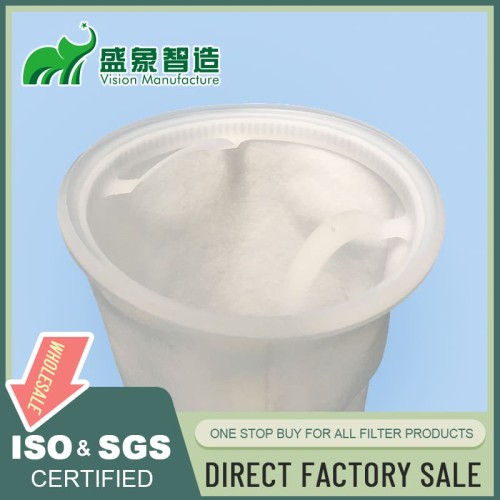
Nylon Mesh Micron Bags Offer Precision in Liquid Filtration
I. Introduction
In industrial settings, precision in liquid filtration is crucial for maintaining product quality and operational efficiency. This section introduces nylon mesh technology, highlighting its importance in achieving high precision in filtration and the critical role of micron ratings in this process.
II. Nylon Mesh Technology
Nylon mesh is renowned for its exceptional properties in filtration applications:
- Properties of Nylon in Filtration Applications: Nylon's chemical resistance, strength, and flexibility make it ideal for various filtration needs.
- Manufacturing Process of Nylon Mesh: Details the production techniques that enhance the mesh's filtration capabilities.
- Advantages Over Other Filter Materials: Discusses why nylon often outperforms alternatives like polyester or polypropylene in specific applications.
III. Micron Rating Explained
Understanding micron ratings is key to selecting the right filter for specific needs:
- Understanding Micron Measurements: Explains what micron ratings represent and their significance in filtration.
- Common Micron Ratings in Nylon Mesh Bags: Reviews typical micron sizes used in industry and their applications.
- Relationship Between Micron Rating and Filtration Efficiency: How the size of the openings in the mesh affects the ability to capture particles.
IV. Applications Across Industries
Nylon mesh micron bags are versatile, used across various sectors:
- Chemical Processing: For filtering impurities out of chemical solutions.
- Pharmaceutical Manufacturing: Ensures the purity of ingredients and final products.
- Food and Beverage Production: Critical for maintaining safety and quality in consumables.
- Water Treatment and Purification: Used in both drinking and wastewater treatment processes.
- Automotive Fluids Filtration: Filters out contaminants in automotive manufacturing processes.
- Electronics and Semiconductor Industry: Ensures the cleanliness of solutions used in delicate manufacturing processes.
V. Design Features
The design of nylon mesh micron bags is tailored to meet specific industrial needs:
- Mesh Weave Patterns and Densities: Affects the filter's strength and efficiency.
- Bag Shapes and Sizes: Customizable to fit various filtration systems.
- Seam Types and Construction Methods: Ensures durability and prevents bypass.
- Customization Options for Specific Needs: Tailored solutions for unique operational requirements.
VI. Performance Characteristics
Nylon mesh bags excel in several performance metrics:
- Flow Rates and Capacity: Handles high volumes efficiently.
- Particle Retention Efficiency: Effectively captures specified particle sizes.
- Chemical Compatibility: Resistant to a wide range of chemicals.
- Temperature Resistance: Performs well under various temperature conditions.
- Durability and Lifespan: Long-lasting under continuous use.
VII. Selection Guide
Choosing the right nylon mesh micron bag involves several factors:
- Determining the Right Micron Rating: Based on the size of particles to be filtered.
- Considering Flow Rate Requirements: Ensuring the bag can handle the system's volume.
- Evaluating Chemical Compatibility: Matching the bag's material properties with the chemicals involved.
- Assessing Temperature Conditions: Ensuring the bag can perform under the operational temperatures.
- Balancing Efficiency and Cost: Finding a cost-effective solution that meets the system's needs.
VIII. Installation Best Practices
Proper installation is crucial for maximizing the effectiveness of nylon mesh micron bags:
- Proper Handling Techniques: Minimizes damage during installation.
- Ensuring Correct Fit and Seal: Prevents bypass and ensures optimal filtration.
- Pre-use Preparation Steps: Essential steps before the bag is put into operation.
- Initial Performance Testing: Ensures the system is functioning correctly from the start.
IX. Cleaning and Reusability
Nylon mesh bags offer significant benefits in terms of maintenance:
- Proper Cleaning Methods: Guidelines for effectively cleaning the bags to extend their life.
- Frequency of Cleaning: Recommendations based on the application and type of contaminants.
- Inspection for Wear and Damage: Regular checks to ensure ongoing reliability.
- Determining When to Replace: Knowing when to replace bags to maintain system performance.
X. Comparative Analysis
Comparing nylon mesh with other synthetic materials highlights its advantages:
- Nylon Mesh vs. Other Synthetic Materials: Evaluates the benefits of nylon over alternatives.
- Woven vs. Non-woven Nylon Filters: Discusses the differences in performance and applications.
- Cost-benefit Analysis in Various Applications: Assesses the economic impacts of using nylon mesh bags.
XI. Case Studies
Success stories from various industries demonstrate the effectiveness of nylon mesh micron bags in enhancing filtration processes, solving specific challenges, and delivering quantifiable improvements.
XII. Future Developments
Emerging technologies and trends in the field of filtration include:
- Integration of Nanofibers in Nylon Mesh: Enhancing filtration precision.
- Smart Filtration with Embedded Sensors: Enabling real-time performance tracking.
- Biodegradable Nylon Alternatives: Developing environmentally friendly materials.
- Advancements in Multi-layer Designs: Improving efficiency and capacity.
XIII. Environmental Considerations
Using nylon mesh bags has a positive environmental impact by:
- Recyclability of Nylon Mesh Bags: Promotes sustainability in filter production and disposal.
- Energy Efficiency in Production and Use: Reduces the overall energy consumption of the system.
- Waste Reduction Through Reusability: Minimizes environmental footprint.
- Eco-friendly Disposal Methods: Encourages responsible end-of-life handling.
XIV. Conclusion
Nylon mesh micron bags are revolutionizing the field of industrial filtration, offering unmatched precision and efficiency. As industries increasingly focus on enhancing filtration processes, these bags provide a reliable and cost-effective solution. For organizations looking to optimize their filtration systems, embracing these advanced solutions is a strategic move towards achieving superior operational outcomes.
Leave a comment

